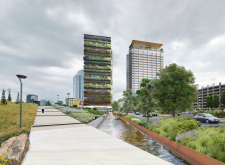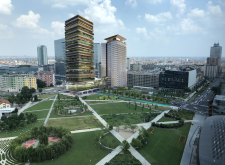5 key facts about this project
Sustainable Vertical Integration
A significant aspect of this project is the implementation of vertical gardens as a key architectural feature. The living facades employ various plant species that contribute to biodiversity and provide improved air quality. This approach not only enhances the building's aesthetics but also serves as a critical component in passive climate control by reducing heat and regulating temperature within the building. The selection of native plants reflects a commitment to sustainability, minimizing water usage and maintenance needs.
The structural materials chosen for the project include reinforced concrete and steel, providing durability while allowing for innovative design possibilities. Large glass panels are utilized in the upper sections of the towers, drawing natural light into interior spaces and offering expansive views of the surrounding urban landscape. This careful selection of materials indicates a dedication to energy efficiency and environmental stewardship.
Thoughtful Site Planning and Landscaping
The project exhibits an integrated approach to landscape architecture, blending built structures with natural environments. Pathways adorned with indigenous flora guide pedestrian movement, fostering an inviting atmosphere for both residents and visitors. The inclusion of water features enhances the microclimate, promoting ecosystems that support local wildlife. These aspects of site planning focus on creating spaces that encourage community interaction while addressing potential urban environmental challenges, such as stormwater runoff.
Moreover, the design encompasses innovative water management systems, ensuring efficient use of resources. Greywater systems and rainwater harvesting initiatives underline the project’s commitment to sustainability, demonstrating how urban developments can contribute positively to their surroundings.
The dual-purpose nature of the towers means that the interiors are adaptable, with spaces catering to various functions, such as residential living, retail, and community amenities. This flexibility allows the project to respond to diverse user needs, enhancing the overall urban experience.
This architectural design serves as a significant example of how contemporary projects can align with ecological principles while fostering community interaction. For more detailed insights into the architectural plans, sections, and overall design ideas, readers are encouraged to explore the project's full presentation. This examination will offer a deeper understanding of the unique design concepts employed and their implications for future urban architecture.
























